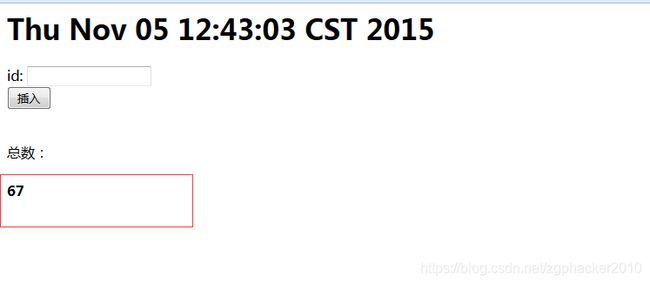spring整合ehcache 注解实现查询缓存,并实现实时缓存更新或删除
写在前面:上一篇博客写了spring cache和ehcache的基本介绍,个人建议先把这些最基本的知识了解了才能对今天主题有所感触。不多说了,开干!
注:引入jar
net.sf.ehcache
ehcache
2.8.3
第一步:首先配置ehcache.xml
第二步:在spring.xml的配置文件中引入schema
xmlns:aop="http://www.springframework.org/schema/aop"和http://www.springframework.org/schema/cache http://www.springframework.org/schema/cache/spring-cache-3.2.xsd
缓存的配置:
OK!缓存的相关配置已经完成。下面开始编写测试程序。这里需要连接数据库,我就不写了。这里为了方便就随便找了之前写过的model,这个model就是AOP注解实现日志管理的实体,为了偷懒就直接用了,希望你们不要误解,没有特殊意义的
第三步:编写model
这里需要注意,要实现缓存的实体必须要序列化 private static final long serialVersionUID = -6579533328390250520L; 关于序列化的生成这里就不介绍了,大家可以百度看看。
package org.shop.entity;
import java.io.Serializable;
import java.util.Date;
public class SystemLog implements Serializable {
private static final long serialVersionUID = -6579533328390250520L;
private String id;
private String description;
private String method;
private Long logType;
private String requestIp;
private String exceptioncode;
private String exceptionDetail;
private String params;
private String createBy;
private Date createDate;
public String getId() {
return id;
}
public void setId(String id) {
this.id = id == null ? null : id.trim();
}
public String getDescription() {
return description;
}
public void setDescription(String description) {
this.description = description == null ? null : description.trim();
}
public String getMethod() {
return method;
}
public void setMethod(String method) {
this.method = method == null ? null : method.trim();
}
public Long getLogType() {
return logType;
}
public void setLogType(Long logType) {
this.logType = logType;
}
public String getRequestIp() {
return requestIp;
}
public void setRequestIp(String requestIp) {
this.requestIp = requestIp == null ? null : requestIp.trim();
}
public String getExceptioncode() {
return exceptioncode;
}
public void setExceptioncode(String exceptioncode) {
this.exceptioncode = exceptioncode == null ? null : exceptioncode.trim();
}
public String getExceptionDetail() {
return exceptionDetail;
}
public void setExceptionDetail(String exceptionDetail) {
this.exceptionDetail = exceptionDetail == null ? null : exceptionDetail.trim();
}
public String getParams() {
return params;
}
public void setParams(String params) {
this.params = params == null ? null : params.trim();
}
public String getCreateBy() {
return createBy;
}
public void setCreateBy(String createBy) {
this.createBy = createBy == null ? null : createBy.trim();
}
public Date getCreateDate() {
return createDate;
}
public void setCreateDate(Date createDate) {
this.createDate = createDate;
}
}第四步:编写dao,service
package org.shop.dao;
import org.shop.entity.SystemLog;
public interface SystemLogMapper {
int deleteByPrimaryKey(String id);
int insert(SystemLog record);
int insertSelective(SystemLog record);
SystemLog selectByPrimaryKey(String id);
int updateByPrimaryKeySelective(SystemLog record);
int updateByPrimaryKey(SystemLog record);
int count();
}public interface SystemLogService {
int deleteSystemLog(String id);
int insert(SystemLog record);
int insertTest(SystemLog record);
SystemLog findSystemLog(String id);
int updateSystemLog(SystemLog record);
int count();
}第五步:编写serviceImpl并添加缓存注解
这里缓存注解的参数不介绍了,不懂得看我上一篇博客,我这里先把需要的注解都写上了,一会一个一个介绍。
@Service("systemLogService")
public class SystemLogServiceImpl implements SystemLogService {
@Resource
private SystemLogMapper systemLogMapper;
@Override
public int deleteSystemLog(String id) {
return systemLogMapper.deleteByPrimaryKey(id);
}
@Override
//@CachePut(value="myCache")
//@CacheEvict(value="myCache",allEntries=true,beforeInvocation=true)
@CacheEvict(value="myCache",key="0",beforeInvocation=true)
public int insert(SystemLog record) {
return systemLogMapper.insertSelective(record);
}
@Override
@Cacheable(value="myCache",key="#id")
public SystemLog findSystemLog(String id) {
return systemLogMapper.selectByPrimaryKey(id);
}
@Override
public int updateSystemLog(SystemLog record) {
return systemLogMapper.updateByPrimaryKeySelective(record);
}
@Override
public int insertTest(SystemLog record) {
return systemLogMapper.insert(record);
}
@Override
@Cacheable(value="myCache",key="0")
public int count() {
int num = systemLogMapper.count();
return num;
}
}第六步:编写controller,即我们的测试
@Controller
@RequestMapping("systemLogController")
public class SystemLogController {
@Resource
private SystemLogService systemLogService;
@RequestMapping("testLog")
public ModelAndView testLog(){
ModelMap modelMap = new ModelMap();
SystemLog systemLog = systemLogService.findSystemLog("c30e2398-079a-406b-a2f7-a85fa15ccac7");
modelMap.addAttribute("data", systemLog);
return new ModelAndView("index",modelMap);
}
@RequestMapping("insert")
@ResponseBody
public boolean Insert(SystemLog record){
systemLogService.insert(record);
return true;
}
@RequestMapping("test1")
public ModelAndView test1(){
ModelMap modelMap = new ModelMap();
int num =systemLogService.count();
modelMap.addAttribute("num", num);
return new ModelAndView("pageEhcache",modelMap);
}
}我们先测试查询的缓存,即serviceImpl中的 findSystemLog(String id) 方法,我们访问testLog.do,第一次运行如下图,注意控制台中的heap和 disk
再一次访问testLog.do,运行你会发现没有访问数据库,如图:
到此查询的缓存我们实现了,但是关于缓存的处理我们并没有做完,我们应该在深入思考下,在上面查询的缓存生命周期内,我们对刚才查询的表进行了增删改操作,这时我们再访问该查询方法,你会发现我们的数据并没有改变,还是增删改操作之前的数据(因为缓存的生命还在),这里是不是问题呢?此时我们需要对查询的缓存进行更新或删除。
下面我们看serviceImpl中的insert方法和count()方法,count的方法是统计表中的数据总记录,insert方法是对该表进行新增一条记录,insert的缓存注解用的是
@CacheEvict(value="myCache",key="0",beforeInvocation=true),这里清除的是指定缓存,也就是count方法中@Cacheable(value="myCache",key="0")的,(serviceImpl中注释的@CacheEvict(value="myCache",allEntries=true,beforeInvocation=true)是清除所有的缓存,这里我就不演示了,道理是一样的)
这里我提供一个测试pageEhcache.jsp页面,
<%@ page language="java" import="java.util.*" pageEncoding="UTF-8"%>
<%
String path = request.getContextPath();
String basePath = request.getScheme()+"://"+request.getServerName()+":"+request.getServerPort()+path+"/";
%>
测试
<%=new Date()%>
这是一个练习
总数:
${num}
我们先访问test1.do,看下表中的记录数并注意控制台变化
页面显示如下,注意总数是67,
再一次访问test1.do,没有访问数据库,说明count()方法的缓存生效了,
接下来开始新增记录,点击插入按钮
注意控制台显示,这里执行了inserSQL语句,并remove了count()方法上的缓存,
接下来再次访问test1.do,我们看到总数变化了,增加了一条,说明我们把之前count()方法上的缓存删除了,又执行了查询总数的sql
再次访问test1.do,count()方法的缓存生效了,对吧!这个就是@CacheEvict注解的作用。
在insert()方法上还有@CachePut(value="myCache")注解,上面的serviceImpl中注释了,它的作用是:@CachePut标注的方法在执行前不会去检查缓存中是否存在之前执行过的结果,而是每次都会执行该方法,并将执行结果以键值对的形式存入指定的缓存中。
总结:
我个人的理解,对查询方法增加缓存容易,但对于缓存的更新的处理就比较麻烦,我上面的serviceImpl中写了三种处理方式,
1.用@CachePut处理,这中方法需要对指定缓存key保持一致,尽管这样,还是不行,因为它返回的缓存是int(增加或删除或修改的记录数或是该记录的对象,这对我们查询所有或部分记录的缓存还是不可行的)
2.用@CacheEvict(value="myCache",key="0",beforeInvocation=true)处理,清除我们指定key的缓存,这种方式缺点是麻烦,需要我们注意每一个缓存的key
3.用@CacheEvict(value="myCache",allEntries=true,beforeInvocation=true)处理,清除所有缓存,这种方式最省事,但会把其他缓存也一同清除。
随着业务的复杂性的不断增加,这些处理方式,可能会增加代码的复杂性,然后我想到的是对DB层进行缓存,可以利用redis,mamchched的进行处理。当然对于一般的web应用运用ehcache已经刻一解决了,但是对大数据量的运用db级别的缓存效果性能可能会更好。
来源:博客园
https://www.cnblogs.com/jianjianyang/p/4938765.html
其他参考资料:
使用Maven搭建Spring+SpringMVC+Mybatis+ehcache项目
Ehcache缓存的使用
企业级框架Ehcache缓存框架(Ehcache和Spring的整合)









